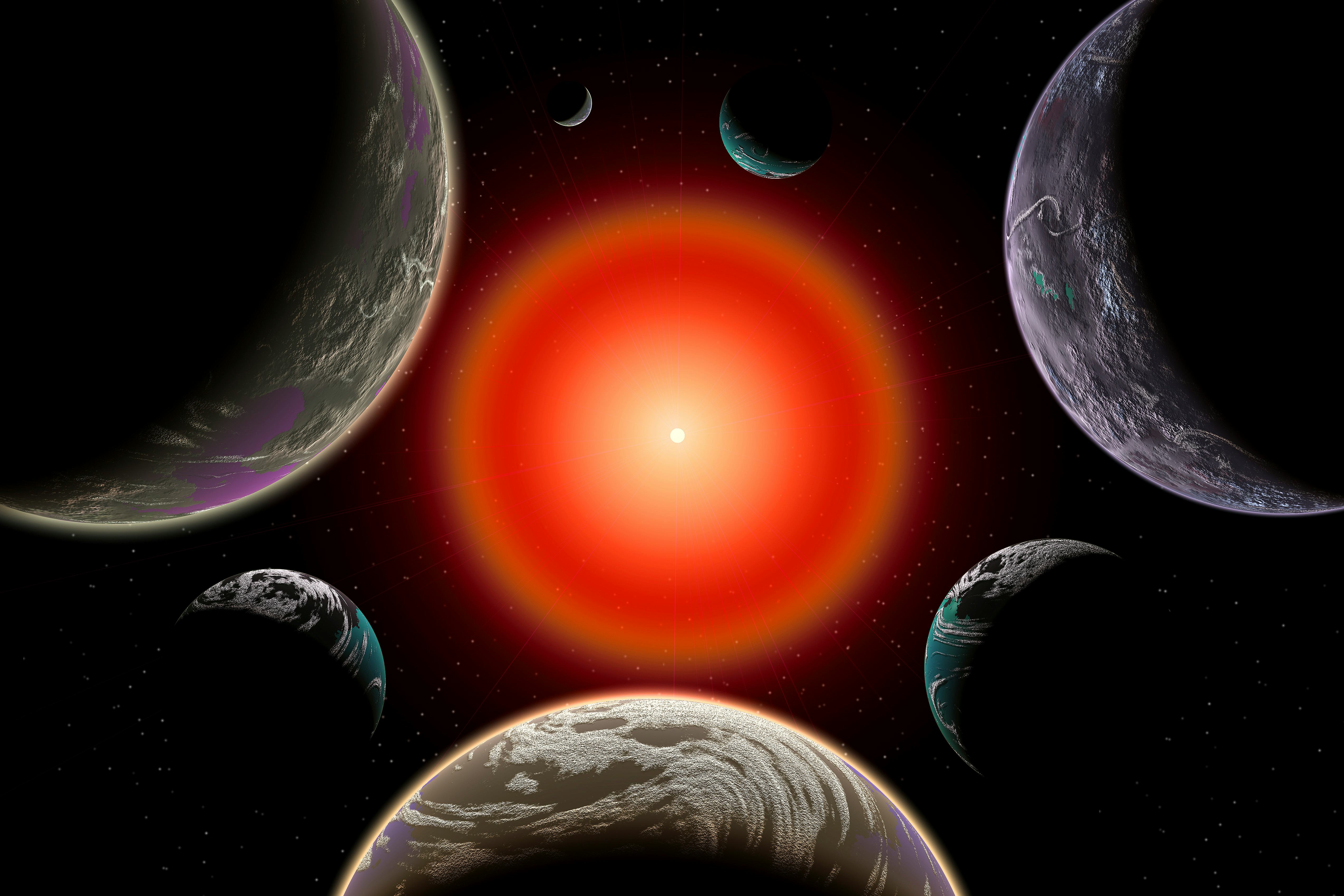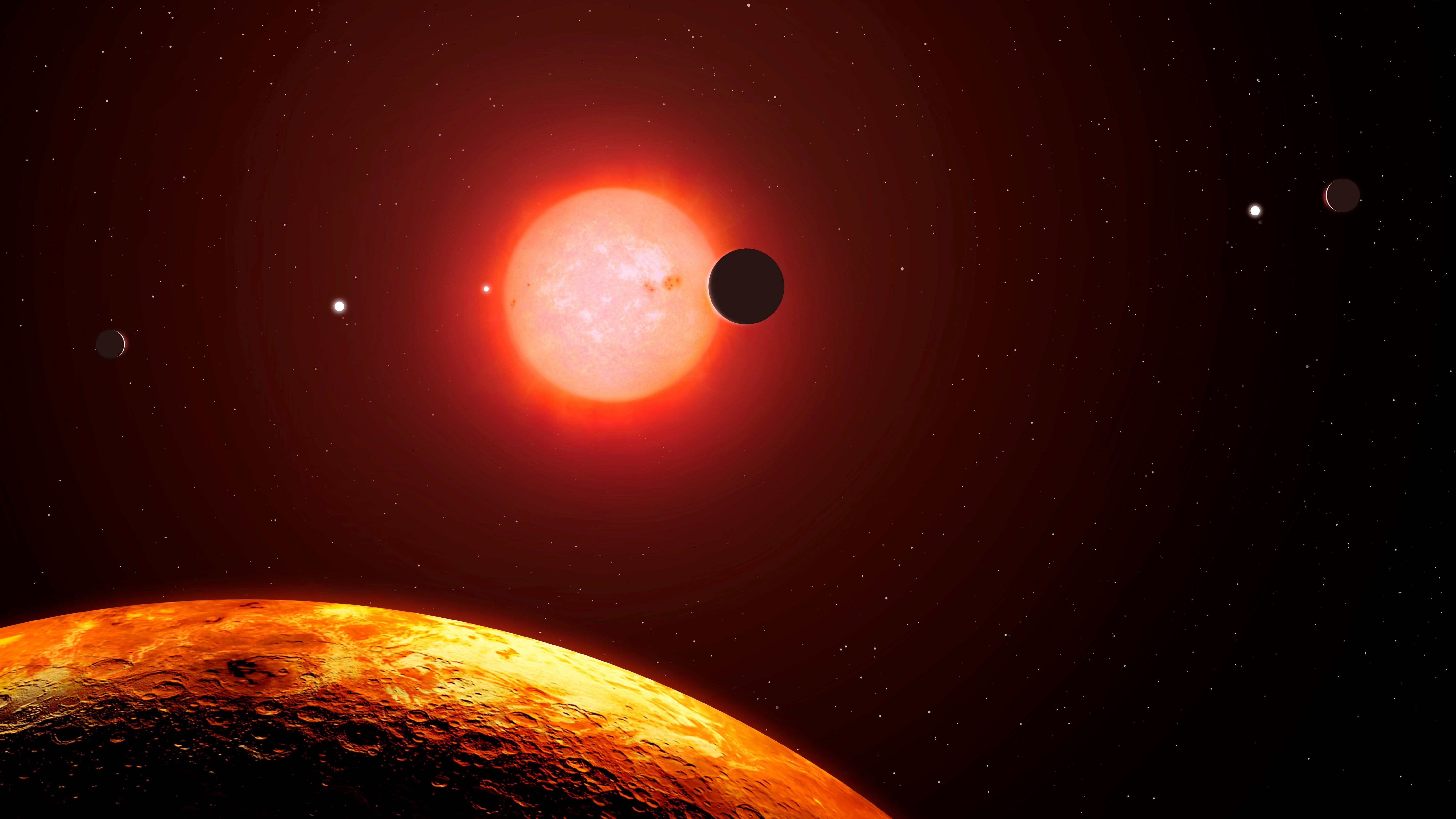
Recent observations with the James Webb Space Telescope suggest that the innermost world of the TRAPPIST-1 system has no atmosphere — or at most, it’s extremely thinly veiled with the tattered remnants of its original atmosphere.
That’s not surprising, given how closely the planet orbits a star with a wild past. But TRAPPIST-1b isn’t necessarily a harbinger of what we’ll find on the other, still potentially habitable worlds of the system. The study was recently published in the journal Nature.
No Atmosphere on TRAPPIST-1b
Trappist-1 is a relatively dim little star, but TRAPPIST-1b orbits close enough that it still gets about four times as much stellar energy as Earth gets from our Sun. NASA astrophysicist Thomas Greene and his colleagues used JWST’s Mid-Infrared Instrument (MIRI) to measure how much of that energy the planet is radiating back into space — and from what part of its surface. To do that, they watched as the planet disappeared behind the star and then reappeared on the other side; astronomers call this a secondary eclipse, and it’s the opposite of a transit (which happens when a planet passes in front of its star).
One cool thing about secondary eclipses is that astronomers can see something that’s otherwise hidden from them: the side of the planet that’s facing the star. TRAPPIST-1b, like most other worlds that orbit extremely close to their stars, is tidally locked. That means the same side of the planet faces the star all the time. When TRAPPIST-1b passes in front of its star, we’re only seeing the dark side of the planet. Secondary eclipses reveal the bright side.

During TRAPPIST-1b’s secondary eclipse, Greene and his colleagues measured how much the infrared light from the star decreased when the planet passed behind it. A little basic subtraction let them calculate how much of the light they saw came from the daylit side of the planet.
It turns out that almost all of TRAPPIST-1b’s heat is being radiated into space from its permanently-sunny dayside. That’s a big clue that TRAPPIST-1b has no atmosphere, or at best a very, very thin one. On planets with atmospheres, even tidally-locked ones, air circulation carries some heat to the nightside of the planet, which helps cool the dayside. But there’s nothing to move heat around on TRAPPIST-1b.
And that probably means no atmosphere, or at least nothing to write home about. The planet’s surface could be just bare rock, open to the vacuum of space, but there could still be a very thin layer of very sparse gas still clinging to the planet.
“We cannot rule out all possible atmospheres for this planet, and at present we cannot completely rule out an atmosphere as thick as the Earth’s atmosphere (although it is disfavored), and even thinner atmospheres cannot be ruled out yet,” NASA astronomer Taylor Bell, a co-author of the recent paper, tells Inverse. Other upcoming observations of TRAPPIST-1b, in slightly different wavelengths of mid-infrared light, will help narrow down what, if anything, is actually left around the planet.
But what about the other six rocky, more-or-less Earth-sized worlds orbiting TRAPPIST-1? It’s too soon to tell, and there’s still a chance that astronomers could find breathable atmospheres on habitable worlds — and that it could happen this year.
There’s Still Hope for Life Around TRAPPIST-1
“TRAPPIST-1b gets four times as much light energy from its star as the Earth gets from the Sun, and maybe that extra energy is why it doesn’t have an atmosphere,” Greene tells Inverse.
TRAPPIST-1b is almost an alien version of Mercury (the actual amount of energy TRAPPIST-1 blasts the planet with is comparable to something in between Mercury and Venus in our own Solar System). That close to a star, charged particles and ultraviolet radiation can strip away a planet’s atmosphere, which is what Greene and his colleagues say probably happened to TRAPPIST-1b.
That’s especially true because TRAPPIST-1, like most red dwarf stars, probably had some very destructive habits in its younger, more hotheaded years. Most red dwarfs spend the first billion years or so of their lives burning especially bright before they settle down into more sedate, hydrogen-burning main sequence stars. Even then, though, these spunky little stars often erupt in violent stellar flares, blasting everything around them with X-ray and ultraviolet radiation. A planet that lives huddled next to a red-dwarf star is in a precarious spot.

“Because planets around M-dwarf stars like TRAPPIST-1 receive so much high-energy light when the planets are young, there is certainly a worry that planets around these stars will be devoid of an atmosphere,” says Bell.
Planetary scientists are still debating whether that’s the unavoidable fate of all planets around red dwarfs, but finding an atmosphere on a vulnerable world like TRAPPIST-1b would have put many of those concerns to rest for good.
“If TRAPPIST-1 b had an atmosphere, then I would have been optimistic that the other worlds would also,” says Greene.
On the other hand, TRAPPIST-1b’s apparent airlessness doesn’t necessarily mean we’re doomed to find nothing on its sibling worlds. The other six TRAPPIST-1 planets orbit in more temperate regions, after all. Three of them are actually in the system’s habitable zone: an area where scientists expect the temperatures to be just right for liquid water on the planets’ surfaces. Those worlds may have a better chance of having atmospheres, too.
“I don’t think we should assume that having 'no atmosphere' (or really no thick atmosphere) on TRAPPIST-1b means that the rest of the planets in the system are also without atmospheres,” says Lewis tells Inverse. “It’s important to think about a concept that has been referred to as the ‘cosmic shoreline,’ where the expectation is that smaller planets closer to a star are more likely to lose their atmospheres.”
The bottom line, according to Greene, is this: “We need to observe the other TRAPPIST-1 planets to see if they have atmospheres.”
“We are still in the early days of studying planets around M-dwarfs,” says Bell, “and we’ll need to study each of the TRAPPIST-1 planets individually to be able to say anything definitive.” And that work is already underway; Lewis and her colleagues plan to observe TRAPPIST-1e as it passes in front of its star in June.







